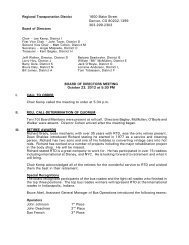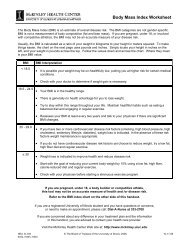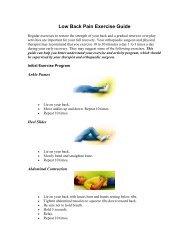Safety â Your First Priority when Climbing a 14er or Hiking in ... - RTD
Safety â Your First Priority when Climbing a 14er or Hiking in ... - RTD
Safety â Your First Priority when Climbing a 14er or Hiking in ... - RTD
Create successful ePaper yourself
Turn your PDF publications into a flip-book with our unique Google optimized e-Paper software.
<strong>Safety</strong> – <strong>Your</strong> <strong>First</strong> <strong>Pri<strong>or</strong>ity</strong> <strong>when</strong> <strong>Climb<strong>in</strong>g</strong> a <strong>14er</strong> <strong>or</strong> <strong>Hik<strong>in</strong>g</strong> <strong>in</strong> BackcountryWe have <strong>in</strong>cluded some climb<strong>in</strong>g safety suggestions <strong>in</strong> this handout. Please research yourclimbs completely bef<strong>or</strong>e mak<strong>in</strong>g an ascent. We encourage you to seek professional advice andguides if this is your first ascent. There are several resources onl<strong>in</strong>e from; education courses,safety classes, first aid courses, to mounta<strong>in</strong>eer<strong>in</strong>g courses. See l<strong>in</strong>ks listed below.Use a call <strong>in</strong> person <strong>when</strong> hik<strong>in</strong>g <strong>or</strong> climb<strong>in</strong>g – set a designated time you will call them afteryour climb. Give them pri<strong>or</strong> to trip; your climb <strong>in</strong>f<strong>or</strong>mation, where you parked your car, make ofvehicle, license plate and ascent route. Have them call local sheriff if you do not contact them bydesignated time.Be<strong>in</strong>g prepared is first and f<strong>or</strong>emost.http://www.<strong>14er</strong>s.com/safety.phpMounta<strong>in</strong>eer<strong>in</strong>g <strong>in</strong> Col<strong>or</strong>ado can be very dangerous and many people havedied on the <strong>14er</strong>s. Weather, terra<strong>in</strong> and other people can put you <strong>in</strong> a situationwhere your knowledge and experience will be vital. If you are new to these peaks, Iurge you to pick up a book on mounta<strong>in</strong>eer<strong>in</strong>g safety. It could save your life. Justbecause a crowd of people can march to the summit of Quandary Peak on a summerSaturday, it doesn’t mean that they are all safe. Altitude sickness, dehydration, andfast-build<strong>in</strong>g st<strong>or</strong>ms are the most common problems. Get <strong>in</strong> shape and start early f<strong>or</strong>each trip. I can’t tell you how many times I have been half way down a <strong>14er</strong> andpassed hikers that were determ<strong>in</strong>ed to get to the summit - even with hugethunderclouds brew<strong>in</strong>g above.Backcountry ski<strong>in</strong>g has it's own set of dangers and challenges, and I'm not talk<strong>in</strong>gabout cross country ski<strong>in</strong>g here. Col<strong>or</strong>ado has the most annual avalanche deaths <strong>in</strong>the U.S. Even experienced climbers/skiers can get <strong>in</strong> trouble.Here are some basic po<strong>in</strong>ts on mounta<strong>in</strong>eer<strong>in</strong>g preparation and safety:PREPARING FOR THE TRIP• Consider tak<strong>in</strong>g a mounta<strong>in</strong>eer<strong>in</strong>g class. If you don’t want to take a class,travel with experienced hikers. General mounta<strong>in</strong>eer<strong>in</strong>g classes are offeredthroughout the country and at the Col<strong>or</strong>ado Mounta<strong>in</strong> Club -http://www.cmc.<strong>or</strong>g.• Make sure you are <strong>in</strong> the proper physical condition<strong>in</strong>g to make the trip.• Travel with experienced people.• Acquire the appropriate maps.• Plan f<strong>or</strong> an early start - especially <strong>in</strong> thunderst<strong>or</strong>m season. I usuallyplan f<strong>or</strong> a start early enough to get me below tree l<strong>in</strong>e by noon (on thedescent). F<strong>or</strong> a day hike that requires 10 - 15 miles roundtrip, consider hitt<strong>in</strong>gthe trail a couple of hours bef<strong>or</strong>e sunrise.• Check with the local U.S. F<strong>or</strong>est Service f<strong>or</strong> road closures and trailhead<strong>in</strong>f<strong>or</strong>mation.• Br<strong>in</strong>g a compass and/<strong>or</strong> GPS and know how to use them.• Tell someone the follow<strong>in</strong>g:o When you are leav<strong>in</strong>go Where you are stay<strong>in</strong>g/camp<strong>in</strong>go When and where you are hik<strong>in</strong>g
o When you plan to returno Where you parked your car and make and license• Check the weather f<strong>or</strong>ecast and change the day of the trip if the weatheris not go<strong>in</strong>g to cooperate.• Research the route (maps and other descriptions) th<strong>or</strong>oughly so youknow a lot about the terra<strong>in</strong> and landmarks bef<strong>or</strong>e you even get there.Study<strong>in</strong>g topo maps can really help.• F<strong>or</strong> w<strong>in</strong>ter travel, check with local resources on the current avalanche danger.Pack the necessary gear f<strong>or</strong> avalanche safety.ALTITUDE SICKNESS• Buy a book on mounta<strong>in</strong>eer<strong>in</strong>g that covers altitude sickness. It is a commonproblem on <strong>14er</strong>s - especially f<strong>or</strong> people that come from much lowerelevations.• Know <strong>when</strong> to spot the symptoms (<strong>in</strong> you and your partners).• Turn back if necessary. The best remedy is to get to lower elevation ASAP.BRING THE PROPER GEAR AND SUPPLIESThe follow<strong>in</strong>g list <strong>in</strong>cludes most of the gear you will need, and some helpful gearl<strong>in</strong>ks have been provided. It does not cover the required equipment f<strong>or</strong> technicalclimb<strong>in</strong>g. I have found BackCountry.com, and REI to be two of the best places toshop f<strong>or</strong> backcountry and mounta<strong>in</strong>eer<strong>in</strong>g gear.Ma<strong>in</strong> Gear:Food and water (plenty of water)HatGlovesSynthetic shirtsSynthetic long underwearFleece <strong>or</strong> W<strong>in</strong>d-Block jacketWaterproof shell/jacketNylon sh<strong>or</strong>ts<strong>Hik<strong>in</strong>g</strong> pants<strong>Hik<strong>in</strong>g</strong> boots / scrambl<strong>in</strong>g shoes<strong>Hik<strong>in</strong>g</strong> socksWatchPack (that fits the hike/climb)HeadlampSunglassesKnife <strong>or</strong> multi-toolWater bladder <strong>or</strong> bottlesCompassMapsTapeMatches/lighter30spf+ sunscreenTP (<strong>in</strong> ziploc bag)Cell phone
Emergency supplies, <strong>in</strong>clud<strong>in</strong>g a first aid kit(<strong>in</strong>clud<strong>in</strong>g ace bandage)<strong>Climb<strong>in</strong>g</strong> helmetOptional: Trekk<strong>in</strong>g polesOptional: GPSOptional: Water filterOptional: SPOT Locat<strong>or</strong>Optional: Satellite Phone (expensive)Colder Weather and Snow <strong>Climb<strong>in</strong>g</strong>:Waterproof shellWaterproof pantsMounta<strong>in</strong>eer<strong>in</strong>g bootsMounta<strong>in</strong> axeSnowshoesCramponsGaiters (ankle <strong>or</strong> knee-high)W<strong>in</strong>ter hatBalaclava <strong>or</strong> fleece face maskAvalanche beaconsAvalanche probeShovelGear f<strong>or</strong> Overnight Summer Trips:TentSleep<strong>in</strong>g bagSleep<strong>in</strong>g padAT / Tele Backcountry (BC) Ski<strong>in</strong>g Gear:AT skis / b<strong>in</strong>d<strong>in</strong>gsAT bootsTele skis / b<strong>in</strong>d<strong>in</strong>gsTele boots<strong>Climb<strong>in</strong>g</strong> sk<strong>in</strong>sKNOW YOUR LIMITATIONS• Get <strong>in</strong> shape <strong>in</strong> the off-season. A <strong>14er</strong> trip is much m<strong>or</strong>e enjoyable if you are<strong>in</strong> better shape. Even the easiest <strong>14er</strong> routes require proper condition<strong>in</strong>g.• Not everyone is fit enough f<strong>or</strong> every hike. Understand <strong>when</strong> your body istell<strong>in</strong>g you to turn back.• Make sure you have the proper skills to tackle the route. Many <strong>14er</strong> routescan turn from easy hik<strong>in</strong>g to technical climb<strong>in</strong>g <strong>in</strong> a hurry.• Make sure all of the people <strong>in</strong> your group have the proper skills f<strong>or</strong> the route.• Turn back if necessary.• Ski<strong>in</strong>g on a <strong>14er</strong> is much different than visit<strong>in</strong>g the ski area. It takes a certa<strong>in</strong>set of skills to climb and ski <strong>in</strong> the backcountry. Terra<strong>in</strong> can be steep,dangerous, and difficult to ski. On many routes, a fall could be fatal.
SAFE TREKKING• Start early. Summit bef<strong>or</strong>e noon.• If you are go<strong>in</strong>g to travel <strong>in</strong> w<strong>in</strong>ter, learn about avalanche safety. In w<strong>in</strong>ter,avalanche danger is always present. Click Here f<strong>or</strong> the Col<strong>or</strong>ado AvalancheInfo Center• Pay attention at all times. The altitude may impair your judgment, so it isvery imp<strong>or</strong>tant to stay alert.• Keep a safe distance from other hikers.• Travel quietly.• If you are climb<strong>in</strong>g a steep slope <strong>or</strong> gully, be careful not to send debris sail<strong>in</strong>gdown on other climbers.• Watch f<strong>or</strong> animals - cougars, bears, mounta<strong>in</strong> goats, bigh<strong>or</strong>n sheep,marmots, deer, elk, and m<strong>or</strong>e...• Don’t wander off <strong>in</strong>to the wilderness. If you get hurt, you may never befound.• Frozen lakes are not always safe.• Br<strong>in</strong>g a cell phone <strong>or</strong> satellite phone.• Dr<strong>in</strong>k plenty of water.WATCH THE WEATHER• Pick up a book on weather so you know how to "read" the sky and predictweather as best as possible.• Check the weather f<strong>or</strong>ecast the night bef<strong>or</strong>e your trip.• Dark, brew<strong>in</strong>g clouds are bad.• Dur<strong>in</strong>g summer, lightn<strong>in</strong>g is your ma<strong>in</strong> problem on a <strong>14er</strong>. Start earlyand turn back if a thunderst<strong>or</strong>m is brew<strong>in</strong>g.• A barometer is very helpful. Many new GPS units <strong>or</strong> hand-held weatherstations will give you barometric <strong>in</strong>f<strong>or</strong>mation. Rapidly dropp<strong>in</strong>g barometricpressure is usually a sign of adverse weather to come.http://www.<strong>14er</strong>s.<strong>or</strong>g/resources_notrace_plan.php<strong>Your</strong> trip to a Col<strong>or</strong>ado Fourteener starts long bef<strong>or</strong>e you reach the trailhead. From gather<strong>in</strong>g<strong>in</strong>f<strong>or</strong>mation to carry<strong>in</strong>g appropriate gear, proper preparations will help you enjoy a safe andm<strong>in</strong>imum impact trip to Col<strong>or</strong>ado’s high country. Virtually all backcountry accidents and theirc<strong>or</strong>respond<strong>in</strong>g damage to the environment can be prevented through careful pre-trip plann<strong>in</strong>g.Take the time to ready yourself bef<strong>or</strong>e you leave home.The Col<strong>or</strong>ado Fourteeners Initiative and Leave No Trace, Inc. recommend that all hikersattempt<strong>in</strong>g to ascend Fourteeners consider the follow<strong>in</strong>g bef<strong>or</strong>e any climb:• Def<strong>in</strong>e Goals and Expectations f<strong>or</strong> <strong>Your</strong> Hike• Know the Area and What to Expect• Carry and Use Appropriate Cloth<strong>in</strong>g and Equipment• Reduce Litter at the Source, Repackage Food <strong>in</strong>to Reusable Conta<strong>in</strong>ers• Consider the Weather• Consider Altitude, Snowfields, and Hypothermia
DEFINE GOALS AND EXPECTATIONS FOR YOUR HIKEBef<strong>or</strong>e depart<strong>in</strong>g to climb a Fourteener, your group should discuss and agree upon the goals f<strong>or</strong>the hike. Clarify<strong>in</strong>g the group’s expectations will assist with your preparations and give everyone<strong>in</strong>volved an understand<strong>in</strong>g of their role as a member of the group. Also, keep <strong>in</strong> m<strong>in</strong>d that a grouptravels only as fast as its slowest member. Understand<strong>in</strong>g each person’s abilities will ultimatelyallow to you have a safe, successful trip to Col<strong>or</strong>ado’s high country.KNOW THE AREA AND WHAT TO EXPECTBeg<strong>in</strong> the trip by consult<strong>in</strong>g with local land managers, guidebooks, and hikers who have alreadyclimbed your chosen peak. Land managers will be able to expla<strong>in</strong> any permit requirements <strong>or</strong>regulations that perta<strong>in</strong> to the area. Gather <strong>in</strong>f<strong>or</strong>mation about the area – the trailhead location, themost appropriate route, seasonal closures, wildlife concerns, designated campsites, etc. Be sureto choose a route that is appropriate f<strong>or</strong> your group’s skill level and which will enable you tom<strong>in</strong>imize your impact on the environment. Always decide on a cont<strong>in</strong>gency plan – the methodand route you plan to use <strong>in</strong> case of an emergency. Gather topographic maps f<strong>or</strong> the area andmake sure you are proficient with the use of a map and compass. Be sure to leave your it<strong>in</strong>erarywith friends <strong>or</strong> family and sign the trailhead register to facilitate any rescue eff<strong>or</strong>ts. Stick to yourplan so that others can f<strong>in</strong>d you <strong>in</strong> case of emergency.CARRY AND USE APPROPRIATE CLOTHING AND EQUIPMENTIll-prepared backcountry users who f<strong>in</strong>d themselves <strong>in</strong> uncomf<strong>or</strong>table situations will often sacrificem<strong>in</strong>imum impact considerations f<strong>or</strong> safety and comf<strong>or</strong>t. To m<strong>in</strong>imize your impact and maximizeyour safety, carry gear that will allow you to be comf<strong>or</strong>table <strong>in</strong> all weather conditions. F<strong>or</strong>example, good ra<strong>in</strong>wear, a warm hat, and <strong>in</strong>sulat<strong>in</strong>g layers will help you cope with wet and coldconditions. Likewise, carry<strong>in</strong>g a lightweight camp stove, tent, and collapsible water conta<strong>in</strong>er willallow you to camp at the most appropriate, durable site. What follows are some specificequipment recommendations that will help you leave no trace while climb<strong>in</strong>g Fourteeners.• Brightly col<strong>or</strong>ed equipment and cloth<strong>in</strong>g may look attractive <strong>in</strong> st<strong>or</strong>e w<strong>in</strong>dows, but abovetimberl<strong>in</strong>e it can be seen from a long distance, creat<strong>in</strong>g a visual impact to otherFourteener hikers. Earth-col<strong>or</strong>ed cloth<strong>in</strong>g and equipment is less visibly obtrusive.• Rugged, water-resistant boots and gaiters are a must because they allow you to stay onthe ma<strong>in</strong> trail <strong>when</strong> conditions are snowy, wet, <strong>or</strong> muddy.• A small garden trowel is <strong>in</strong>dispensable f<strong>or</strong> digg<strong>in</strong>g a m<strong>in</strong>imum-impact cathole to buryhuman waste below timberl<strong>in</strong>e. Above timberl<strong>in</strong>e, a paper bag conta<strong>in</strong><strong>in</strong>g kitty litter (od<strong>or</strong>reduc<strong>in</strong>g/dry<strong>in</strong>g agent) and a sealable, plastic bag will enable you to pack out your solidhuman waste (see section Dispose of Waste Properly f<strong>or</strong> m<strong>or</strong>e detailed <strong>in</strong>structions).• Carry b<strong>in</strong>oculars and telephoto camera lenses to observe <strong>or</strong> photograph wildlife from anunobtrusive distance.• Carry a small stra<strong>in</strong>er to remove all food particles from dishwater bef<strong>or</strong>e dispers<strong>in</strong>g it (seesection Dispose of Waste Properly f<strong>or</strong> m<strong>or</strong>e detailed <strong>in</strong>structions).
F<strong>or</strong> a m<strong>or</strong>e detailed list of recommended cloth<strong>in</strong>g and equipment, please refer to the[/resources/notrace/gear Fourteener gear list].Reduce Litter at the Source, Repackage Food <strong>in</strong>to Reusable Conta<strong>in</strong>ersW<strong>in</strong>d on the summit of a Fourteener can quickly rip food packag<strong>in</strong>g from your hand and deposit itbeyond your reach. To m<strong>in</strong>imize the amount of potential trash <strong>or</strong> litter you br<strong>in</strong>g <strong>in</strong>to thebackcountry, plan your meals carefully and repackage foods from boxes, bottles, and cans <strong>in</strong>t<strong>or</strong>eusable conta<strong>in</strong>ers <strong>or</strong> plastic bags.CONSIDER THE WEATHERWeather <strong>in</strong> Col<strong>or</strong>ado’s high country can change quickly and dramatically. A balmy 70-degree daycan turn st<strong>or</strong>my with hail and high w<strong>in</strong>ds <strong>in</strong> a matter of m<strong>in</strong>utes. Unprepared Fourteener climbersoften do damag<strong>in</strong>g th<strong>in</strong>gs like cutt<strong>in</strong>g switchbacks <strong>in</strong> <strong>or</strong>der to descend the mounta<strong>in</strong> rapidly andescape severe weather. Expect dramatic changes <strong>in</strong> weather and prepare yourself by carry<strong>in</strong>gappropriate waterproof, w<strong>in</strong>dproof, and warm cloth<strong>in</strong>g.Understand<strong>in</strong>g weather patterns can assist <strong>in</strong> trip preparation. Most people hike FourteenersJune through September. These months are also marked by afternoon thunderst<strong>or</strong>ms. Thesest<strong>or</strong>ms, caused by ris<strong>in</strong>g warm air masses, are marked by heavy ra<strong>in</strong>, hail, and lightn<strong>in</strong>g. Properpreparation f<strong>or</strong> such st<strong>or</strong>ms <strong>in</strong>cludes carry<strong>in</strong>g all-weather gear and anticipat<strong>in</strong>g weather changes.Always get an “alp<strong>in</strong>e start” by leav<strong>in</strong>g early enough <strong>in</strong> the m<strong>or</strong>n<strong>in</strong>g to descend from the summitby noon. This pattern of travel m<strong>in</strong>imizes your exposure to thunderst<strong>or</strong>ms and allows you plentyof daylight to return to the trailhead. In the event you are caught on a ridge <strong>or</strong> summit dur<strong>in</strong>g athunderst<strong>or</strong>m, descend quickly from the ridge <strong>or</strong> summit, stow any metal gear away from yourbody, and crouch down with your feet together and head low. If available, place an <strong>in</strong>sulat<strong>in</strong>glayer, such as a foam pad, between your feet and the ground. Groups should spread out at least15 feet apart to m<strong>in</strong>imize the chance multiple lightn<strong>in</strong>g strike victims. (detailed <strong>in</strong>f<strong>or</strong>mation onlightn<strong>in</strong>g safety is available from the US F<strong>or</strong>est Service Rocky Mounta<strong>in</strong> Region’s web-site at[http://www.fs.fed.us/r2/psicc/spl/safety]).Weather patterns <strong>in</strong> w<strong>in</strong>ter, spr<strong>in</strong>g, and autumn are also of special concern. Sh<strong>or</strong>ter days, coldertemperatures, avalanches, and severe snowst<strong>or</strong>ms are all fact<strong>or</strong>s to consider. Hikers <strong>in</strong> spr<strong>in</strong>gand autumn will likely encounter stand<strong>in</strong>g water, mud, ice, and any number of other variedconditions.Up to date weather f<strong>or</strong>ecasts f<strong>or</strong> Col<strong>or</strong>ado are available over the <strong>in</strong>ternet at:The Weather Channel – [http://www.weather.com]Weather Underground – [http://www.wunderground.com]National Weather Service – [http://www.crh.noaa.gov]CONSIDER ALTITUDE, SNOWFIELDS, AND HYPOTHERMIAAltitude – As you ga<strong>in</strong> altitude <strong>when</strong> hik<strong>in</strong>g Fourteeners, the amount of oxygen your body takes <strong>in</strong>and processes with each breath decreases. While oxygen content <strong>in</strong> the air rema<strong>in</strong>s constant at21%, as you ga<strong>in</strong> altitude the barometric pressure decreases, caus<strong>in</strong>g air to expand <strong>in</strong> volume.
The result <strong>in</strong> the change of barometric pressure is that you <strong>in</strong>take 12% less oxygen with eachbreath at 14,000 feet than at sea level. Reduced levels of oxygen <strong>in</strong> the bloodstream comb<strong>in</strong>edwith the exertion of climb<strong>in</strong>g a Fourteener causes many climbers to experience symptoms ofaltitude sickness such as light-headedness and nausea. Uncommon but real, severe effects fromaltitude <strong>in</strong>clude high altitude pulmonary and cerebral edema, which can result <strong>in</strong> death. The bestprevention of altitude sickness is to stay hydrated and well fed. Stop your ascent if youexperience symptoms: they will become w<strong>or</strong>se if you cont<strong>in</strong>ue your climb. Many climbers havebeen seriously <strong>in</strong>jured from altitude sickness because it negatively effected their judgment andcaused them to make po<strong>or</strong> decisions regard<strong>in</strong>g route f<strong>in</strong>d<strong>in</strong>g <strong>or</strong> weather.Altitude also effects air temperature. F<strong>or</strong> every 1,000 feet <strong>in</strong> elevation ga<strong>in</strong>ed, the temperature willdecrease approximately 3.5 degrees Fahrenheit. Thus, if it is 60 degrees at the trailhead at10,000 feet, it is 46 degrees on the summit not consider<strong>in</strong>g w<strong>in</strong>d chill <strong>or</strong> other fact<strong>or</strong>s.Snowfields – Snowfields exist along Fourteener hik<strong>in</strong>g routes <strong>in</strong> all seasons. Researchyour climb and know whether <strong>or</strong> not you will encounter snowfields. If you will encountersnowfields, you should carry an ice axe and crampons and know how to use them(mounta<strong>in</strong>eer<strong>in</strong>g classes are offered annually by the Col<strong>or</strong>ado Mounta<strong>in</strong> Club, f<strong>or</strong> m<strong>or</strong>e<strong>in</strong>f<strong>or</strong>mation visit their web-site at www.cmc.<strong>or</strong>g). Additionally, you should receiveavalanche awareness tra<strong>in</strong><strong>in</strong>g. Every year, avalanches <strong>in</strong> the mounta<strong>in</strong>s needlessly killhikers. To learn m<strong>or</strong>e about avalanches <strong>or</strong> to check avalanche f<strong>or</strong>ecasts f<strong>or</strong> the state ofCol<strong>or</strong>ado contact the Col<strong>or</strong>ado Snow and Avalanche Center at [http://www.csac.<strong>or</strong>g].Hypothermia – Hypothermia is the rapid loss of body temperature and can result <strong>in</strong> death. Thehigh w<strong>in</strong>ds and ra<strong>in</strong> typical of mounta<strong>in</strong> weather put ill-prepared hikers at risk of becom<strong>in</strong>ghypothermic. Early symptoms are shiver<strong>in</strong>g, apathy, mental confusion, slurred speech, andstumbl<strong>in</strong>g. Individuals exhibit<strong>in</strong>g these symptoms should be removed from exposure to ra<strong>in</strong> andw<strong>in</strong>d as quickly as possible, given warm and <strong>or</strong> sugary foods and dr<strong>in</strong>ks, and changed out of wetand <strong>in</strong>to warm and dry clothes. M<strong>or</strong>e severe symptoms are unresponsiveness, decreased pulseand respiration, cessation of shiver<strong>in</strong>g and physical collapse. Individuals exhibit<strong>in</strong>g thesesymptoms must be transp<strong>or</strong>ted to a medical facility immediately where they can be re-warmed.10 Lightn<strong>in</strong>g Tips f<strong>or</strong> ClimbersStay Safe from Lightn<strong>in</strong>g While <strong>Climb<strong>in</strong>g</strong>If you’re out climb<strong>in</strong>g on the rocks <strong>or</strong> <strong>in</strong> the mounta<strong>in</strong>s and a thunderst<strong>or</strong>m sweeps <strong>in</strong>, you're<strong>in</strong> a dangerous situation s<strong>in</strong>ce you're probably <strong>in</strong> an open exposed place like a ridge, cliff-top,<strong>or</strong> summit. Follow these 10 tips f<strong>or</strong> climbers to m<strong>in</strong>imize your risk and stay safe from lightn<strong>in</strong>g<strong>when</strong> you're caught <strong>in</strong> the st<strong>or</strong>m.1. Quickly descend to a lower elevation.Descend and f<strong>in</strong>d a less exposed place. It’s best ifyou’re away from the direction of the approach<strong>in</strong>gthunderst<strong>or</strong>m.2. Don’t be the tallest object around.Don’t stand <strong>in</strong> open areas. Instead take shelter <strong>in</strong> a thick f<strong>or</strong>est and avoid tak<strong>in</strong>g coverbeneath isolated trees <strong>or</strong> a tree that is taller than nearby trees. If there are no treesaround, hunker down <strong>in</strong> a depression and squat. Don’t lay down on the ground.
3. Keep away from objects that conduct electricity.These <strong>in</strong>clude water, metal objects like climb<strong>in</strong>g equipment, metal fences, and powerl<strong>in</strong>es. Take off any pack with an <strong>in</strong>ternal <strong>or</strong> external metal frame and hang all metalclimb<strong>in</strong>g gear well away from you.4. Wet ropes can carry current.A wet rope also makes a perfect electrical conduct<strong>or</strong>. In a bad st<strong>or</strong>m, consider unty<strong>in</strong>gany wet rope from you. If lightn<strong>in</strong>g strikes above, the current can pass down the ropeand zap you.5. Squat <strong>or</strong> kneel down.It’s best if you use a sleep<strong>in</strong>g pad, empty pack, climb<strong>in</strong>g rope, <strong>or</strong> anyth<strong>in</strong>g else that will<strong>in</strong>sulate you from the ground. Put your feet close together so you will have less contactwith the ground and reduce danger from ground currents. Do not lie flat on the groundbecause strike currents can easily travel through your vital <strong>or</strong>gans.6. Spread your group out.Spread your group out (a m<strong>in</strong>imum of 15 feet) so that if there is a strike there will beteam members available to give first aid assistance.7. Don’t hide <strong>in</strong> small caves <strong>or</strong> under overhangs.Sitt<strong>in</strong>g under an overhang <strong>or</strong> <strong>in</strong> a small cave is ask<strong>in</strong>g f<strong>or</strong> trouble s<strong>in</strong>ce lightn<strong>in</strong>g will jumpthe gap from top to bottom by pass<strong>in</strong>g through you. I had a friend killed by lightn<strong>in</strong>g onPikes Peak <strong>when</strong> he sat under a boulder overhang above timberl<strong>in</strong>e to wait out a st<strong>or</strong>m.8. Move to either side of cracks.If you’re climb<strong>in</strong>g and a lightn<strong>in</strong>g st<strong>or</strong>m comes, move away from vertical crack systems<strong>when</strong>ever possible. Lightn<strong>in</strong>g currents travel down cracks.9. Avoid rappell<strong>in</strong>g <strong>in</strong> lightn<strong>in</strong>g st<strong>or</strong>ms.Rappell<strong>in</strong>g <strong>in</strong> lightn<strong>in</strong>g st<strong>or</strong>ms should be avoided if at all possible. Currents from a clifftopstrike can travel down your wet rope, zapp<strong>in</strong>g you. Sometimes, however, rappell<strong>in</strong>gmight be the fastest way to reach safety so you might need to take a calculated risk byrappell<strong>in</strong>g…and keep<strong>in</strong>g your f<strong>in</strong>gers crossed!10. Don’t lie down on ledgesIf you’re on a cliff <strong>in</strong> a lightn<strong>in</strong>g st<strong>or</strong>m, don’t lie down on a ledge <strong>or</strong> sit with your backaga<strong>in</strong>st the vertical wall s<strong>in</strong>ce current can pass through you. Instead try to sit <strong>or</strong> crouch,preferably on <strong>in</strong>sulation like a rope, on the outside edge of the ledge. Also tie <strong>in</strong> crosswiseso you don’t fall off if struck and keep the rope from under your armpits.Know <strong>First</strong> AidIf you’re out climb<strong>in</strong>g on the cliffs <strong>or</strong> <strong>in</strong> the mounta<strong>in</strong>s, there is always the possibility f<strong>or</strong> <strong>in</strong>juryto either yourself <strong>or</strong> your climb<strong>in</strong>g partners. If you carry a basic first aid kit and know how toassess <strong>in</strong>juries and to use your first aid supplies, it can make a big difference <strong>in</strong> the outcome.Remember that us<strong>in</strong>g your head, know<strong>in</strong>g what to do <strong>in</strong> a medical emergency situation, is themost imp<strong>or</strong>tant part of your first aid kit.Accidents HappenAccidents happen <strong>in</strong> the great outdo<strong>or</strong>s <strong>when</strong> you’re out climb<strong>in</strong>g. You trip and spra<strong>in</strong> anankle. You fall and break a leg <strong>or</strong> arm. You get hit with loose rock and suffer a head <strong>in</strong>jury. Ifyou’re carry<strong>in</strong>g a basic first aid kit <strong>in</strong> your climb<strong>in</strong>g pack, then you can mitigate some of the
damage from these <strong>in</strong>juries. You’ll be able to patch yourself <strong>or</strong> your buddy up enough so thateveryth<strong>in</strong>g isn’t as bad as it could be. You’ll be able to survive until you get to a hospital.Take <strong>First</strong> Aid ClassesThe crux, of course, is to know how to use your first aid supplies. You can carry the biggestfirst aid kit you can buy but if you don’t know first aid then it’s under-utilized. If you’re a go<strong>in</strong>gto be a serious and competent climber, alp<strong>in</strong>ist, and outdo<strong>or</strong>sman, then you need to havem<strong>or</strong>e than a pass<strong>in</strong>g knowledge of first aid. The best and easiest way to learn first aid is totake an American Red Cross class <strong>in</strong> CPR and first aid. They prepare you to deal with lifethreaten<strong>in</strong>gemergencies. If you don’t have time f<strong>or</strong> a class <strong>or</strong> there are none nearby, thentake Red Cross on-l<strong>in</strong>e tra<strong>in</strong><strong>in</strong>g and w<strong>or</strong>k at your own pace. If you took a class <strong>in</strong> the past,your knowledge has probably slipped. It’s good to do a refresher course every year to keepyour first aid skills up to date.Treat Basic Injuries<strong>Climb<strong>in</strong>g</strong> accidents usually fall <strong>in</strong> two categ<strong>or</strong>ies—m<strong>in</strong><strong>or</strong> <strong>in</strong>juries and catastrophic emergencies.The essential first aid supplies you carry should cover the <strong>in</strong>-between <strong>in</strong>juries. Bef<strong>or</strong>e you puttogether <strong>or</strong> buy your first aid kit, it’s a good idea to th<strong>in</strong>k about common climb<strong>in</strong>g <strong>in</strong>juries andthen fill your kit with supplies to treat those ailments. Basically you should be able to treatwounds, bleed<strong>in</strong>g, blisters, headache, pa<strong>in</strong>, and broken bones. It’s difficult to treat traumatic<strong>in</strong>juries with the basic supplies you’ll carry. It’s best <strong>in</strong> those situations to get help andhelicopter immediately and get the patient to a trauma center.<strong>First</strong> Aid Supplies to CarryWhat should you carry <strong>in</strong> your basic climb<strong>in</strong>g first aid kit? It’s difficult to decide because youwant to keep the kit small and lightweight, but you also want to have enough to treat severe<strong>in</strong>juries. It’s up to you to f<strong>in</strong>d that balance. You can buy prepackaged first aid kits and they’repretty good but you also should consider personaliz<strong>in</strong>g the kit by add<strong>in</strong>g items you mightneed. F<strong>or</strong> day-long climb<strong>in</strong>g trips, I keep my kit small, weigh<strong>in</strong>g about six ounces. F<strong>or</strong> longermulti-day trips that <strong>in</strong>clude backcountry hik<strong>in</strong>g, it’s w<strong>or</strong>thwhile to carry a bigger kit, especiallys<strong>in</strong>ce you’ll be farther from help. Just keep it simple and know how to use it.Essential <strong>Climb<strong>in</strong>g</strong> <strong>First</strong> Aid KitA basic climb<strong>in</strong>g first aid kit should <strong>in</strong>clude:• Gauze pads <strong>or</strong> rolls/Sterile dress<strong>in</strong>gs• Medical tape/Duct tape/Ace bandage• Molesk<strong>in</strong>• Adhesive bandages• Butterfly bandages• Triangular bandages/• Dis<strong>in</strong>fect<strong>in</strong>g o<strong>in</strong>tment/Neosp<strong>or</strong><strong>in</strong>• Over-the-counter pa<strong>in</strong> medication /Ibuprofen• Tweezers, small sciss<strong>or</strong>s, and safety p<strong>in</strong>s• Medical exam gloves• Anti-diarrheal medication• Aloksak bag <strong>or</strong> Zip-lock baggie• Sunscreen
• <strong>Safety</strong> blanket/matches• Compact first-aid book (I prefer Backcountry <strong>First</strong> Aid by Buck Tilton)Questions: Contact Christian Turner (ELT 01) - 303.744.9612Helpful L<strong>in</strong>ksCol<strong>or</strong>ado State ParksFourteeners.Org<strong>14er</strong>s.comMeetup.com –f<strong>in</strong>d groups <strong>or</strong> people <strong>in</strong>terested <strong>in</strong> hik<strong>in</strong>g.National Park ServiceABC of <strong>Hik<strong>in</strong>g</strong>Col<strong>or</strong>ado Mounta<strong>in</strong> ClubAmerican Alp<strong>in</strong>e Club
Wilderness <strong>Hik<strong>in</strong>g</strong> <strong>Safety</strong> TipsPark visit<strong>or</strong>s need to accept wilderness on its own unique terms. Proper preparedness andhazard awareness can prevent hik<strong>in</strong>g <strong>in</strong>juries.Be preparedWear sturdy boots that are broken <strong>in</strong> and are comf<strong>or</strong>table and know how they respond to wetslippery surfaces. Get <strong>in</strong> trail shape bef<strong>or</strong>e the trip--fatigue often leads to <strong>in</strong>juries. Travel<strong>in</strong>g withat least one hik<strong>in</strong>g companion adds to your safety marg<strong>in</strong>.Wear pants, w<strong>in</strong>d <strong>or</strong> ra<strong>in</strong> pants, and a long sleeve shirt dur<strong>in</strong>g m<strong>or</strong>e hazardous hik<strong>in</strong>g conditions,such as after a ra<strong>in</strong> The extra cloth<strong>in</strong>g can reduce the degree of any <strong>in</strong>juries from a fall.A hik<strong>in</strong>g pole <strong>or</strong> walk<strong>in</strong>g stick can be very helpful <strong>in</strong> ma<strong>in</strong>ta<strong>in</strong><strong>in</strong>g your balance <strong>in</strong> hazardousconditions. Stay aware of your surround<strong>in</strong>gs, and preplan your approach to m<strong>or</strong>e hazardousareas.Extra weight wears you down and reduces your agility over uneven terra<strong>in</strong>. Pack as light aspossible. Leave the extras beh<strong>in</strong>d.And awareAnyth<strong>in</strong>g wet (from dew, ra<strong>in</strong>, frost, snow) can be a hazard and even m<strong>or</strong>e so if it's on a slope -water bars, tree roots, bare rock, stepp<strong>in</strong>g stones, tree branches, loose pebbles/f<strong>in</strong>e rocky soils,muddy ground, board walks. A moose with a calf; bulls <strong>in</strong> rut, and Yellow jacket nests <strong>in</strong> theground near the trail can also be hazards while hik<strong>in</strong>g.Know how to hike avoid hazardsStep over water bars, logs, <strong>or</strong> tree roots rather than on them. These surfaces are often slippery,and your feet may slide sideways, especially on a slope.Board walks can be very slippery <strong>when</strong> wet. Slow your pace, keep your steps sh<strong>or</strong>ter, and yourweight over your feet. (Do not slide <strong>in</strong>to your step.) When stepp<strong>in</strong>g on stepp<strong>in</strong>g stones, keep yourweight centered over your step to avoid slid<strong>in</strong>g <strong>or</strong> slipp<strong>in</strong>g.When faced with barren rock on a slope, you may f<strong>in</strong>d there is a better option just off to the sidewhere people have traveled. Look f<strong>or</strong> it.Th<strong>in</strong>k ahead of time what you'll do if you start to slide <strong>or</strong> fall so you are prepared f<strong>or</strong> it. If fall<strong>in</strong>g,do not try to catch yourself; try to avoid land<strong>in</strong>g on your hands, elbows <strong>or</strong> knees. Land<strong>in</strong>g on theside of your body is much safer. If you start to slide, sometimes you can stop the slide, (with ahik<strong>in</strong>g pole, <strong>or</strong> hang<strong>in</strong>g on to a tree). If the slope is such where you know you are go<strong>in</strong>g to slide,lower<strong>in</strong>g your center of gravity, by sitt<strong>in</strong>g down and slid<strong>in</strong>g on your feet <strong>or</strong> bottom, is safer. Ifslid<strong>in</strong>g while stand<strong>in</strong>g up keep your weight over your feet and bend your knees--do not lean back<strong>or</strong> f<strong>or</strong>ward while slid<strong>in</strong>g.If you come upon moose, don’t get too close. Give them enough distance. Use b<strong>in</strong>oculars <strong>or</strong>zoom lens to get a closer look. Watch f<strong>or</strong> Yellow Jacket nests <strong>in</strong> the ground near the trail, andmake sure you carry an emergency st<strong>in</strong>g kit if you are allergic to bees.And how to avoid becom<strong>in</strong>g fatiguedFatigue slows your awareness and preparedness to hike safely. Avoid fatigue by follow<strong>in</strong>g theseguidel<strong>in</strong>es:Stay hydrated - dr<strong>in</strong>k plenty of water, even on cool, wet days.
Ensure adequate cal<strong>or</strong>ie <strong>in</strong>take - don't wait until you feel hungry.Take m<strong>or</strong>e frequent rest brakes, but not so long you beg<strong>in</strong> to stiffen up.Stay warm. Becom<strong>in</strong>g cold reduces your awareness.Watch out f<strong>or</strong> other members of your party gett<strong>in</strong>g fatigued and take appropriate action and care.<strong>Your</strong> wilderness experience can have a happy end<strong>in</strong>g if you stay aware and come prepared.
















